How to configure SSO for users on inSync Cloud using JumpCloud as IdP
This article applies to:
- Product edition: inSync Cloud
- Only a Druva Cloud administrator can set up Single Sign-on.
- Configure Single Sign-on based on the applicable scenarios:
- New Druva customers (on-boarded after July 14, 2018) must configure Single Sign-on using the Druva Cloud Platform Console. For more information, see Set up Single sign-on.
- Existing Phoenix and inSync customers who already have configured Single Sign-on must continue to use the existing Single Sign-on settings of Phoenix and the Single Sign-on settings of inSync as applicable.
- Druva recommends generating the SSO token only once. If the token is generated again, the older SSO token registered with the IdP becomes invalid. Hence, if you generated a new SSO token, update the IdP details accordingly.
Overview
This article provides the steps to configure SSO for users on inSync Cloud using JumpCloud as IdP.
Configuration steps:
- Configure a custom Druva app for inSync Cloud on JumpCloud portal
- Configure JumpCloud Single Sign-On
- Configure inSync Cloud to use JumpCloud login
- Assign Users/Groups in JumpCloud to use Druva app
- Enable SSO for users
Configure a custom Druva app for inSync Cloud on JumpCloud portal

To configure a custom app:
- Log in to the JumpCloud Admin Portal: https://console.jumpcloud.com.
- Go to Applications and click
 to configure a new application.
to configure a new application. - Search for SAML.
- Click Configure.
Configure JumpCloud Single Sign-On
Under the Configure SAML section, there are several configurable fields. Only the required configurations are specified below and the rest can be omitted with their default values.
Provide the values for the fields as described below:
- DISPLAY LABEL: Enter the name for the Application. For example, Druva or Druva App.
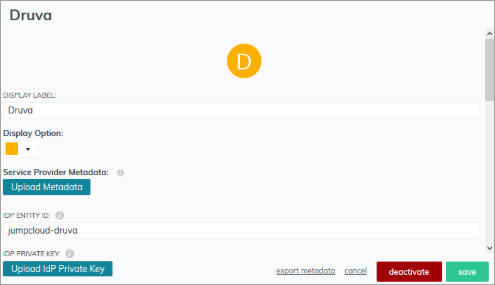
- IDP ENTITY ID: This is the unique, case-sensitive identifier used by JumpCloud for the service provider. This is a mandatory field, although the value supplied to this field is not required on the Service Provider end. For example, you can enter jumpcloud-druva.
- IDP PRIVATE KEY and IDP CERTIFICATE: Generate a public certificate and private key pair to connect Druva application to JumpCloud with the below steps.
Windows users- To create a certificate, install OpenSSL. Download and install the latest version of OpenSSL (full installation) from: http://slproweb.com/products/Win32OpenSSL.html
OpenSSL requires Visual C++ 2008 redistributables, which are available from the same website. The bitness of Visual C++ depends on the bitness of the downloaded openSSL. - Once the OpenSSL is installed, navigate to OpenSSL directory and run the following command:
Set OPENSSL_CONF=c:\openssl-win64\bin\openssl.cfg
This command sets the location for OpenSSL configuration file. - Download the openssl.cnf file using the link https://jumpcloud.desk.com/customer/...cnf?1565716806 and rename the downloaded file to openssl.cnf and then place it in the below path.
C:\<Installation path of Software>\openssl-win64\bin - From the command prompt run openssl.exe
- From the OpenSSL> command prompt, run the following commands to generate a new private key and public certificate.
OpenSSL> genrsa -out myprivatekeytest.pem 2048
OpenSSL> req -new -x509 -key myprivatekeytest.pem -out mypublic_certtest.pem -days 3650 -config .\openssl.cnf
- Fill out the form to complete the certificate creation. The form appears similar to the screenshot below:
This generates the key valid for 3650 days. Once it expires it has to be generated again.
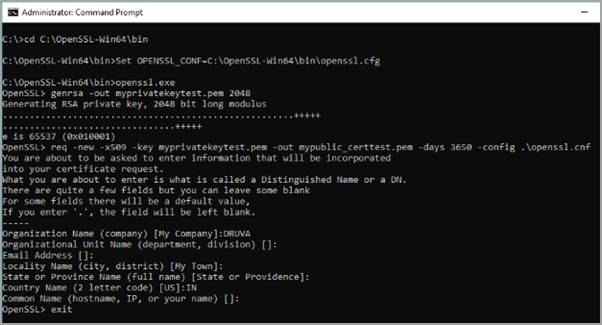
This operation generates a key pair from which myprivatekeytest.pem can be used as IdP Private key and mypublic_certtest.pem can be used as IdP certificate.
- Click Upload IdP Private Key browse and select the myprivatekeytest.pem file from the directory C:\<Installation path of Software>\openssl-win64\bin and click Open .
- Click Upload IdP Certificate browse and select the mypublic_certtest.pem file from the directory C:\<Installation path of Software>\openssl-win64\bin and click Open.
- Open the terminal for Linux or Mac and run the following commands:
openssl genrsa -out private.pem 2048
openssl req -new -x509 -sha256 -key private.pem -out cert.pem -days 1095
- Fill out the form to complete the certificate creation. It will appear similar to the screenshot below:
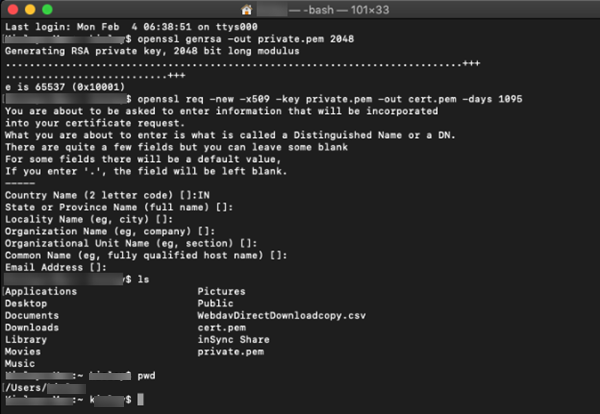
This generates the key which is valid for 1095 days. Once it expires, it has to be generated again.
- Click Upload IdP Private Key browse and select the private.pem file and click Open.
- Click Upload IdP Certificate browse and select the cert.pem file and click Open.
- To create a certificate, install OpenSSL. Download and install the latest version of OpenSSL (full installation) from: http://slproweb.com/products/Win32OpenSSL.html
- SP ENTITY ID: Enter druva-cloud in this field.
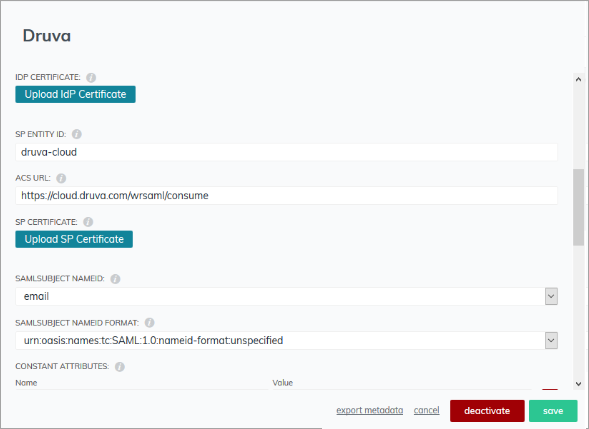
- ACS URL: Enter https://cloud.druva.com/wrsaml/consume.
- SAMLSUBJECT NAMEID & SAMLSUBJECT NAMEID FORMAT: Retain the default selection of email & urn:oasis:names:tc:saml:1.0:nameid-format:unspecified respectively.
- CONSTANT ATTRIBUTES: Click +add attribute button and add the constant attribute. In the Name field, enter the insync_auth_token and in the Value field enter the SSO token generated from the admin console. (How to generate an SSO token).

- GROUPS ATTRIBUTE NAME: Leave this field entry as memberOf.
- SIGNATURE ALGORITHM: Retain entry as RSA-SHA256.
- IDP URL: The default value of this field is https://sso.jumpcloud.com/saml2. Provide a unique name after this field as shown below.
https://sso.jumpcloud.com/saml2/<Enter a unique name>
Sample: https://sso.jumpcloud.com/saml2/druvasso
Configure inSync Cloud to use JumpCloud login
To configure Single Sign-on follow the below steps:
- Log in to https://login.druva.com as an administrator.
- Go to
 > Settings.
> Settings. - Open the Single Sign-On tab and click Edit.
- On the Single Sign-On Settings window, add the details as described below:
- ID Provider Login URL: Enter the URL created in the step 10 of the second section.
- ID Provider Certificate: Open your mypublic_certtest.pem in a Notepad and copy its content to this field. The file was generated in step 3 of the second section.
- Retain the default values in the remaining fields and click Save.
Assign Users/Groups in JumpCloud to use Druva app
Create a user
- Click Users in JumpCloud console.
- Click the
 plus icon.
plus icon.
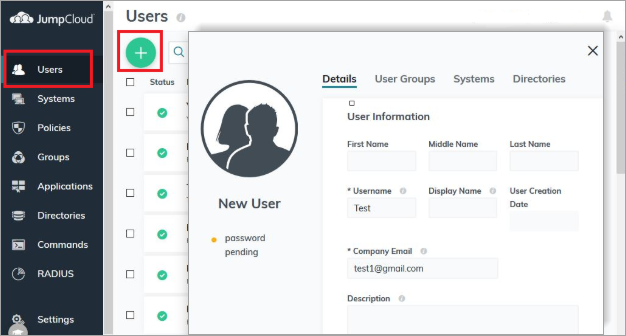
- Fill the mandatory details like Username and Company email address.
- Click Save user.
Create Groups
- Click Groups.
- Click the
 plus icon and select Create Group of Users.
plus icon and select Create Group of Users.

- Enter the name of the group.
- Open the Users tab.

- Select the users you want to assign to this group.
Assign Application to the users
- Open the group created before.
- Open the Applications tab.
- From the list of applications, select Druva.
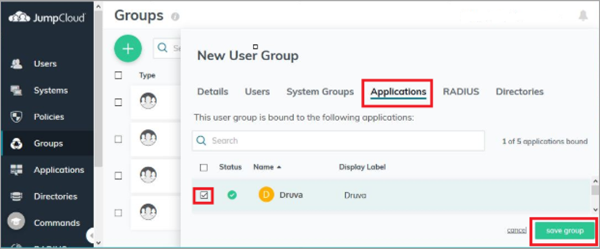
Enable SSO for users
Login to Druva Cloud portal and enable the option to login using “Single Sign On” for desired users (This can be only done at Profile level and not user level). It is necessary to have the users assigned to a specific profile who are privileged to use SSO instead of inSync Password or Active Directory.
- Login to inSync Management Console and select the profile to be configured for SSO.
- On the General tab, select Single Sign-on as login mechanism under User Privacy & Access.
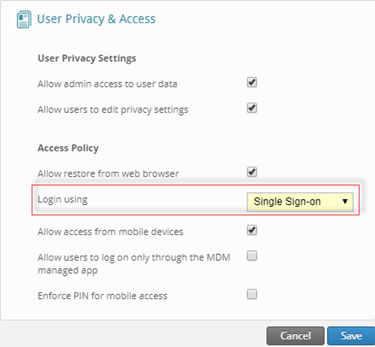
- Click Save

